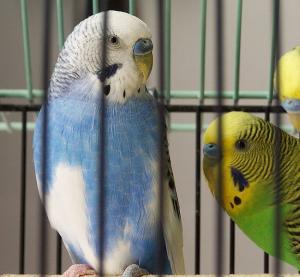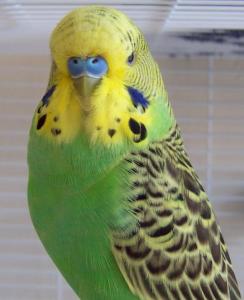Keeping Parakeets (Budgies) as Pets

Parakeets (Melopsittacus undulatus) are one of the most commonly kept pet birds. They are also known as budgerigars or budgies.
Parakeets are medium sized, colorful birds from Australia that belong to the parrot family, Psittacidae.
Like other birds of the parrot family, parakeets can be taught to talk.
Parakeets (or budgies) are typically some variation of blue and white or green and yellow. In general, the heads of older parakeets will be of a solid color (usually white or yellow). Young birds tend to have stripes on the heads and so you can usually tell the age of a parakeet by the amount of striping on the forehead.
Notice the heads of the birds in the above photo. Their heads are of a solid color. Now take a look at the photo below of a younger parakeet and notice the striping on its head.

Parakeets and Talking
Parakeets are relatively inexpensive birds (about $15-$20 each) and part of their appeal (besides their fantastic color) is that like other members of the parrot family, parakeets can be trained to talk.
Unlike the larger parrots, it is generally assumed that parakeets don't know what they are saying, but that they are only mimicking sounds that they have heard. While this may be true, keep in mind that at one time it was assumed that larger parrots didn't know what they were saying either.
Also, keep in mind that not all parakeets will talk. A parakeet kept singly will generally learn to talk much easier than a pair of parakeets. However, it is generally best to keep a pair of parakeets anyway, otherwise your bird may get lonely. I think it is better to have a happy bird even if it never learns to speak like a human.
This is especially true if you are at work all day long and if you are not home to keep your bird entertained. By getting your bird a companion your bird will be much happier.
This doesn't mean that it is impossible to teach a pair of parakeets to speak, but it is harder.
To teach your parakeet to talk you will need to repeat the same phrases over and over again and eventually your parakeet may begin to say these phrases.
Just as young humans have an easier time learning a new language, it is easier to teach young birds to speak than older birds.
Also, keep in mind that once your bird learns to speak it may chatter all day long. I happen to like this, but not everyone does.
To hear a parakeet talking watch the You Tube video below. I love this video! Watching it makes me want to run right out and get a parakeet right now!
As you can tell from the video, parakeets can be quite chatty. Well cared for parakeets can live for 10 or more years so before buying a parakeet know that you will have the constant chatter for up to 15-16 years.
Sexing Your Parakeets
Although not a foolproof method, you can usually tell the sex of your adult parakeets by the color of the cere. The cere is the nostril region. In males it is bluish and in females this region is brownish or pinkish in color. For some excellent photos showing the cere of male and female parakeets please see Birds Online: Everything About Budgies.
Housing Your Parakeets
As with other pet birds, the largest cage you can afford is best. Parakeets also need out of cage time. Parakeets are tame birds and like to interact with their human owners. Be careful not to let your parakeet fly out of an open door or window, and use caution if you have other pets, such as cats or dogs.
What this also means is that you'll need spend some time with your parakeet each day and so plan for this.
Parakeets also enjoy toys. Watch the cute You Tube below to see a parakeet playing with a ball.
Other Supplies You'll Need
- Perches
- Cuttlebone
- Food
- Water
- A variety of toys so that your parakeet doesn't get bored
There are some regulations regarding bringing a pet bird into Ireland from non-EU countries. If you apply for Ireland citizenship by descent and plan on moving to Ireland full-time you'll want to make sure that your birds can travel into the country with you.
